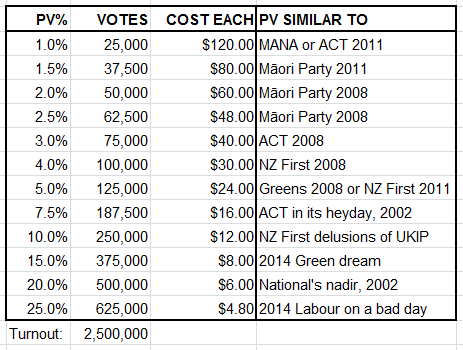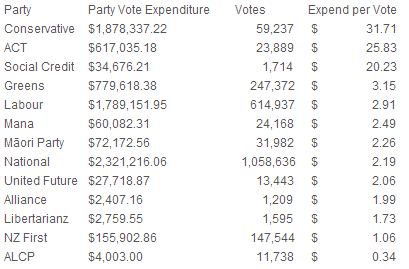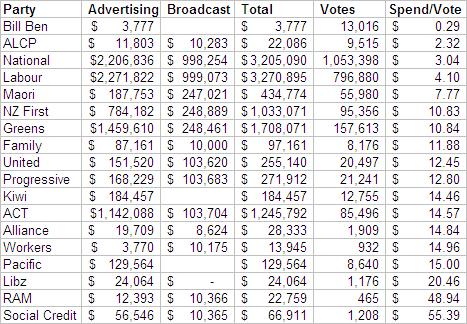Phil Sage in comments to my previous post about Internet MANA observes that “The question is whether Kim Dotcom’s money will translate into poll support and votes.” I have no knowledge of what’s going on inside the Internet MANA HQ bar what’s been reported in the media, but those reports indicate a large full-time campaign staff, and that will burn a large share of the money. Matthew Hooton was on the wireless yesterday scorning this approach and saying the money will be pumped into glossy brochures and Internet ads nobody will watch. Which might be fair enough.
But wait, we actually have some data! Each election, David Farrar helpfully puts together a breakdown of party votes won versus dollars spent (CPV). The 2008 and 2011 tables were stolen from DPF, with thanks.
In 2011, almost all parties spent less than $5 per vote — exceptions were the Conservatives ($32), ACT ($26) and Social Credit ($20).
In 2008 the expenditure was higher and the field more spread, probably because the result was less certain and the stakes higher. (EDIT: Also, it appears the broadcast allocation was not included in the 2011 figures). The two main parties again spent less than $5, most others spent $10-15, and there were two outliers — RAM ($49) and Social Credit ($55).
Internet MANA in 2014
Turnout in both those elections was famously modest (2.2-2.4 million). Since both Labour and Internet MANA are trying to mobilise the “missing million” let’s assume turnout increases to 2.5 million in 2014, which yields a nice round 25,000 party votes per 1%. Let’s also assume that Internet MANA only spends the $3 million put in the pot by Kim Dotcom, which in reality will be higher.

The first point here is that high polling tends to correlate with low CPV. Incumbency and brand value count for a great deal. So it is unlikely that any new party would be able to achieve good CPV by any means. To match the major parties Internet MANA would need to poll 25%, in which scenario Labour would effectively cease to exist. Even though that’s only a little over half of the “missing million”, it’s not happening.
My guess in the post was that Internet MANA would get 2-3% for $3 million. That would mean per-vote spending of around $50, far higher than any of the parties in 2011, on a par with the unelectable outliers in 2008. I still think that’s the most likely outcome.
If they tank and gain only what the combined Internet and Mana parties are polling now (1-1.5%) they would have outspent 2011’s most profligate parties by a factor of three in terms of CPV. This has to be the worst conceivable outcome for Internet MANA, and even so, it very probably yields them a second MP, assuming either Hone Harawira or Annette Sykes wins their seat. Anything more than this is gravy. Te Mana teaming up with Kim Dotcom is, at least tactically, a no-lose situation.
If they match 2011 CPV outliers the Conservatives, they would need to pull at least 100,000 votes — a tenth of their missing million — which would yield 5-7 MPs and make them a force to be reckoned with between now and 2017, giving them a platform to profoundly disrupt the plans of every other party in NZ politics. It’s unlikely, but with this sort of money, it’s not impossible.
UPDATE: Andrew Geddis points out in comments that I’ve failed to account for the electoral spending limit, which prevents Internet MANA from blowing the whole $3 million on declarable election expenses, which is what the cited 2008 and 2011 numbers cover. The expenditure limit is $25,700 for a constituency candidate and $1,091,000 for a registered political party plus $25,700 per electorate contested by the party.
So all the CPV figures in that last table are about double what they will be in reality, which means the premise and conclusions of this post are rather weaker than they seemed.
L



If IMP gain an electorate seat, how many more party votes per list seat to gain more MPs?
It depends on many factors, but the second seat tends to come in around 1.5%. In 2011 both ACT (1.07%) and Mana (1.08%) missed out. You have to go back to 2005 to see it, when Progressive (1.16%) missed out, ACT (1.51%) got one, and UnitedFuture (2.67%) got two.
But the exact point changes based on how the other votes break down. Some mathematicians at Auckland University made a calculator, here: https://www.stat.auckland.ac.nz/~geoff/voting/
L
Pingback: Kiwipolitico » Blog Archive » What is success for Internet MANA?
You’re not quite comparing apples with apples here. The campaign spending figures quoted only include “election expenses” – meaning spending on election advertising. On top of this, parties will have spent considerably more on things like opinion polling, staff hires, rent on campaign offices, etc. None of that shows up on public records. Meaning that the apparently low spending per vote for parties like Labour and National is misleading – they will really have spent lots more than the figures given.
Furthermore, the Internet Party can’t spend all its $3 million on advertising (the law limits it to something like $1.5 million, depending how many electorate candidates it runs). And as you note, it’ll already be spending lots of this money on hiring people like Graeme Edgeler, etc, to run the show. So equating the $3 million figure with previous apparent spends on election campaigns just doesn’t work (or, at least, doesn’t work in anything like the simple way you suggest.)
All of which is to say that saying “if they match 2011 CPV outliers the Conservatives, they would need to pull 100,000 votes” is plain wrong.
Andrew,
Oh, you’re right. I assumed staffing costs and similar would be a wash with any other donations, the broadcasting allocation, and so on, but failed to factor in the spending cap.
So all those CPV equivalents are at least half what the table says.
L
I had the same thought but all it means is that the CPV on declared election expenses for your estimate of 2-3% will come down to around or below Conservatives/ACT 2011. That $50 seemed a bit high.
The regulated period starts on 20 June I think so they don’t have long to get everything established. I doubt KDC wants to play with electoral law. :)